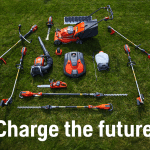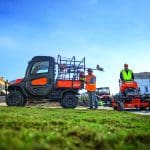
Sponsored Content by Milwaukee Tool
The professional landscaping industry is experiencing an increasing shift from gas-powered to battery-operated equipment, introducing new solutions to many professional operators. Driven by emerging gas and noise-related restrictions, as well as the ease of use provided by many gas-alternative products, these solutions introduce new practices and maintenance requirements to a professional’s workday. To maximize the benefits of battery-powered solutions and a professional’s investment, it is important to understand what to consider in making this transition.
Battery Technology
Investing in a battery system that provides the power and run-time demanded by professionals, as well as compatibility system-wide, is one important factor to consider. By purchasing tools from a single brand with an interchangeable battery system, businesses can maximize run-time and versatility to increase efficiency while simultaneously saving money on long-term tool and gas maintenance. For users in the Milwaukee M18™ battery system, this provides compatibility between outdoor products as well as other power tools, such as impact wrenches or SAWZALL® Reciprocating Saws.
As a longtime industry leader in battery technology, Milwaukee Tool understands what it takes to combine batteries, motors, and electronics to deliver disruptive innovation. Unparalleled levels of design and engineering have provided the ability to take significant leaps forward with REDLITHIUM™ batteries, which feature world-class cell technology to deliver the highest-performing packs in the industry. A unique patented design ensures the batteries can withstand harsh environments, while the robust electronics package monitors the cells to protect and optimize performance for every tool and battery combination.
With the success and power delivered in their battery technology, Milwaukee continues to replace gas-powered equipment through a strong dedication to understanding user needs and driving battery, motor, and electronics technology into the outdoor power equipment space, being the force continuing to move the battery-powered industry forward.
Performance
Significant developments in technology integration have allowed many battery-powered equipment solutions, such as mowers, blowers, chain saws, and pruning shears, to become more intelligent, powerful, and ergonomic. However, it is important to invest in manufacturers dedicated to delivering innovative solutions with technologies that deliver the power required for daily, professional applications to maximize the benefits of this shift. Through countless hours working alongside professionals on the job, Milwaukee Tool understands the demanding requirements of the professional landscaper and has worked to drive productivity on the properties they maintain.
Battery Management and Infrastructure
In transitioning from gas-powered equipment to battery-operated solutions, professionals must carefully assess their power requirements to ensure sufficient charging infrastructure, allowing for a seamless and long-term implementation.
- An initial consideration should involve determining a crew’s battery needs by understanding the expected applications and workload. Recognizing the various power outputs necessary for different projects and applications is important in ensuring the crew has sustained power throughout the day, allowing continued productivity and minimizing downtime.
- Understanding a crew’s charging requirements is crucial for determining how power will be delivered. Factors such as overnight charging versus having access to daytime charging significantly impact a company’s preferred approach to meeting these needs. Regardless of the chosen method, crews must develop charging routines that ensure they can carry out their work without disruptions caused by a lack of charged batteries. Investing in an equipment manufacturer with versatile and mobile charging solutions is crucial to maximizing this investment. Milwaukee Tool’s new ROLL-ON™ 7200W/3600W 2.5kWh Power Supply, for example, brings power to the toughest environments, featuring an integrated non-removable, REDLITHIUM™2.5kWh Battery to reduce the number of batteries that a crew must invest in. By providing the ability to charge batteries anywhere, crews can reduce downtime and maximize productivity. Also fully compatible with the PACKOUT™ Modular Storage System, the new ROLL-ON™ introduces a mobile charging solution for battery-powered crews.
- A complete assessment of a business’s infrastructure needs is essential. An important first step is evaluating a crew’s operational demands and scale of work to determine how many battery packs will be needed to get the job done. Once this number is finalized, the charging needs to support this battery supply can be determined. Milwaukee Tool’s M18™ PACKOUT™ Six Bay RAPID Charger, for example, provides professionals the ability to manage six batteries and consolidate their charging experience. Compatible with the PACKOUT™ modular storage system, this charger is optimized for transportation and storage on and off the jobsite, delivering unmatched charging portability. As businesses begin to transition to battery-operated equipment, investing in a battery system that offers versatile and rapid charging solutions will reduce downtime and maximize battery packs in use. Milwaukee’s M18™ system, with charging solutions such as the PACKOUT™ Six Bay RAPID Charger, M18™ Dual Bay Simultaneous Super Charger, and new ROLL-ON™ 7200W/3600W 2.5kWh Power Supply stands as an example of a solution designed to maximize a professional’s workday. Finally, ensuring a business has sufficient electrical circuitry to support these charging needs is crucial to properly support the charging requirements of these battery packs. By addressing these considerations, professionals can successfully navigate the transition to battery-operated equipment, ensuring a seamless and uninterrupted workflow.
Final Thoughts
As the landscaping industry moves into the future, user’s expectations of battery-powered equipment are evolving with new innovations. Understanding these levels of performance, compatibility, and power management needs will be important as professionals are looking to invest in a battery system, helping to choose a battery platform that will meet their needs in both the short term and long term.



